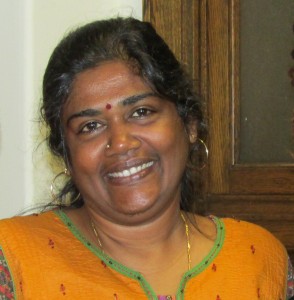N. Anandavalli
CSIR-Structural Engineering Research Centre,
CSIR Campus, Taramani, Chenai 600 113
INDIA
Email: [email protected]
Background:
Dr. N. Anandavalli is a Principal Scientist of the Shock and Vibration Group at the CSIR-Structural Engineering Research Centre in Chennai, India. She spent April to July 2015 with the group and she is now back in Chenai.
Her research is towards enhancing the shock resistance capability of new as well as existing structures / structural components. Efficient and simplified modelling strategies for air and contained blast loading was developed by her to predict response behaviour of blast loaded structures. Her contribution towards knowledge generation in the area of blast resistant design of large capacity laced reinforced concrete (LRC) explosive storage structures are significant. Design has reduced the separation distance by about 30% and was proved successful through field trials. She was involved in the evolution of Laced Steel-Concrete Composite (LSCC) system by innovative integration of structural elements. This system possess enhanced ductility and rotational capacity and maintains structural integrity avoiding sudden failure, which finds application in structures resisting suddenly applied loads with spin-off for other applications too. Conventional finite element modelling of Reinforced Concrete (RC) / LRC / LSCC requires steel and concrete to be modelled separately, which is tedious and time consuming. To alleviate this, she has formulated a simplified approach, which treats RC/LRC/LSCC as homogenous material, which has significantly reduced the computational demand in analyzing such structures. Currently, she is involved in developing strategies for blast protection of structures. Her research interests include blast response behaviour of structures, computational methods, sustainable materials and multi-scale modelling of cement based composites. Her research contributions are towards strategic area, which is of national importance.
Project at JHU:
Concrete is a widely used material for construction of infrasturcutre such as buildings, bridges, nuclear containment vessels, power plant strucutres, explosive storage structures, etc. Research towards understanding the material behaviour is essential for enhancing their mechanical properties. Concrete is considered as homogenous at macro scale, while it is heterogenous in nature. At meso scale, concrete is a multi-phase material. With the advancement in numerical and computational methods, engineers can understand the behaviour of the materials before they are incorporated in the design procedure. Failure characteristics can be analysed in advance so that the material is efficiently utilised. She was awarded the ‘Raman Research Fellowship’ to conduct research on Investigations on behaviour of concrete using meso scale models at Johns Hopkins University with Prof. Somnath Ghosh. During the fellowship she was involved in:
- Development of geometrical model of meso scale structure of concrete using digital image processing based on cellular automata theory
- Development of algorithm for generation of random aggregate arrangement based on take and place method


